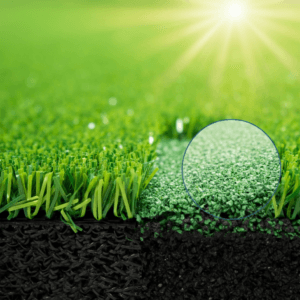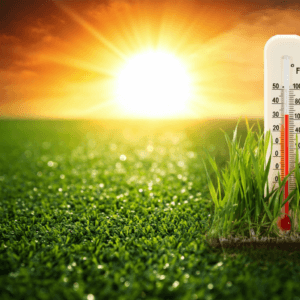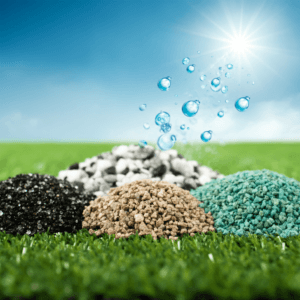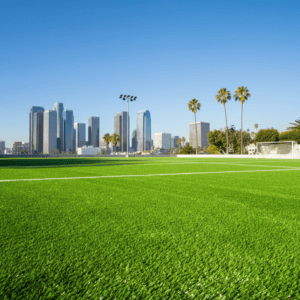Artificial Turf Heat: How Hot Does It Get? Tips to Keep It Cool in Los Angeles
Introduction
Artificial turf is an excellent alternative to natural grass, especially in dry and drought-prone areas like Los Angeles. It’s low-maintenance, eco-friendly, and always looks green. However, one common concern homeowners have is how hot artificial turf gets in the summer. Since synthetic grass is made from plastic and rubber materials, it can retain heat more than natural grass. The intense Los Angeles sun can significantly impact artificial turf, with high temperatures affecting its longevity and surface temperature.

So, how hot does artificial turf actually get? More importantly, how can you keep it cool in hot weather? In this guide, we’ll break it all down and provide you with the best tips for keeping your synthetic lawn comfortable, even on the hottest days. Selecting high-quality fake grass is crucial to ensure better heat dissipation, which can help prevent discomfort during summer months.
Understanding Artificial Turf Temperature
When considering artificial grass for your home, especially in hot climates like Arizona, understanding the temperature dynamics of synthetic turf is crucial. During the peak of summer, the surface temperature of artificial turf can soar up to 180°F, making it essential to choose the right materials to keep it cool.
While artificial turf is generally cooler than concrete or asphalt, it can still get hotter than natural grass, particularly in direct sunlight. The type of synthetic fibers used in the turf plays a significant role in its temperature. Some fibers are specifically designed to reduce heat absorption, ensuring the surface remains cooler.
Infill materials also impact the surface temperature of synthetic grass. For instance, crumb rubber tends to absorb more heat compared to other infill options. Opting for lighter-colored artificial grass can help keep the surface temperature down, as it reflects more sunlight and absorbs less heat.

A simple yet effective way to cool down synthetic grass is by spraying it with water from a hose. This can immediately reduce the surface temperature, making it more comfortable for pets and kids. Additionally, installing misting systems can help maintain a cooler artificial lawn, especially in warmer climates where the sun’s radiation can quickly heat up the turf.
Ample shade is another critical factor in reducing the surface temperature of artificial grass. Whether through natural shade from trees or man-made structures like pergolas, providing shade can dramatically lower the temperature of your synthetic lawn.
Moreover, new scientifically-developed infill sands are available that can reduce surface temperatures by 30-50°F. These advanced infill materials are an excellent option for artificial turf installations in hot climates, ensuring your lawn remains cool and comfortable even on the hottest days.
How Hot Does Artificial Turf Surface Temperature Get?
Artificial turf can reach temperatures of 130-160°F on extremely hot summer days, depending on factors like:
✅ Direct sunlight exposure – Turf in full sun will heat up more than shaded areas. ✅ Material composition – Some turf types retain heat more than others. ✅ Infill type – Rubber infill can absorb more heat than silica sand or cooling infill. ✅ Color & Density – Darker and denser artificial grass will absorb more heat.
Artificial turf can reach temperatures significantly higher than the surrounding air temperature, emphasizing the risks of using synthetic turf in hot environments.
In comparison, natural grass usually stays 20-30°F cooler because it contains moisture that evaporates and cools the surface. However, artificial turf is still completely safe with proper care and cooling solutions.

Does Artificial Grass Get Too Hot for Pets and Kids?
If you have dogs, kids, or frequently walk barefoot on your lawn, it’s important to consider heat levels. On very hot days, artificial turf may become too warm to walk on barefoot, but there are many ways to reduce heat buildup. Compared to real grass, artificial grass maintains its appearance and requires less maintenance, while also providing tips on keeping it cool for pets and children during extreme temperatures. Pet-friendly artificial turf and cooling solutions can make a big difference.
How to Keep Artificial Turf Cool in Hot Weather
If you’re concerned about heat retention in synthetic grass, here are some of the best ways to keep your turf cool. When property owners install artificial grass, they often worry about potential issues such as temperature during summer months.
One effective method is to use the right infill material. Different types of infill materials, such as sand and crumb rubber, can significantly impact the performance and longevity of artificial grass. Choosing the appropriate infill material can help manage heat and maintain the turf’s appearance.
1. Choose a Lighter & Heat-Resistant Turf
Not all artificial grass is the same. Some types are designed with heat-resistant materials to reduce temperature buildup. Lighter-colored turf also retains less heat than darker shades.
2. Use Cooling Infill to Reduce Surface Temperatures
Regular infill (like rubber or silica sand) can absorb and retain heat. Instead, opt for cooling infill such as:
- Envirofill – Helps reduce heat absorption.
- HydroChill – Absorbs moisture and releases it slowly, keeping the turf cooler.
- Zeolite Infill (Triple Z Zeolite) – A natural cooling option that also reduces pet odors.

3. Install Shade Structures
Adding shade elements can significantly reduce artificial turf temperature. Consider:
☀️ Pergolas – Provide stylish and functional shade.
☀️ Trees & Bushes – Natural shade helps keep the area cool.
☀️ Shade Sails – An affordable and effective solution for backyard turf areas.
4. Rinse Your Turf with Water
On extremely hot days, a quick spray of water over artificial grass can cool it down by 30-50°F in just minutes. If you have pets or kids playing outside, this is a simple way to keep the surface comfortable.
5. Install Turf Over a Heat-Reflective Base
A proper base layer can reduce heat absorption. Using materials like crushed stone or reflective underlays can prevent heat from being trapped beneath the turf.
6. Use Artificial Turf with Heat-Reducing Technology
Newer artificial turf products are engineered to reflect UV rays and reduce surface heat. Choosing a high-quality turf designed for Los Angeles’ hot climate can make a big difference.

Best Artificial Turf for Hot Weather
At Revive Landscape, we install high-quality artificial turf designed to withstand Los Angeles heat while keeping your outdoor space comfortable. We offer:
✔ Pet-friendly artificial turf
✔ Heat-resistant and UV-reflective turf
✔ Cooling infill for maximum temperature control
✔ Durable synthetic grass for high-traffic areas
Final Thoughts: Is Artificial Turf Too Hot for Los Angeles Homes?
Artificial turf does retain more heat than natural grass, but with the right installation techniques, cooling infill, and shading solutions, it remains a safe and comfortable option for homes and businesses in Los Angeles. If you’re considering artificial grass but are concerned about the heat, our team at Revive Landscape is here to help you find the perfect turf solution for your space.
Get a Free Artificial Turf Consultation in Los Angeles
Ready to install heat-resistant artificial turf? Contact Revive Landscape today for a free consultation and discover how we can help you keep your yard green, cool, and beautiful all year long.
📞 Call us at: 818-257-1540
📧 Email us at: contact@revivelandscape.com
🌐 Visit us at: ReviveLandscape.com
